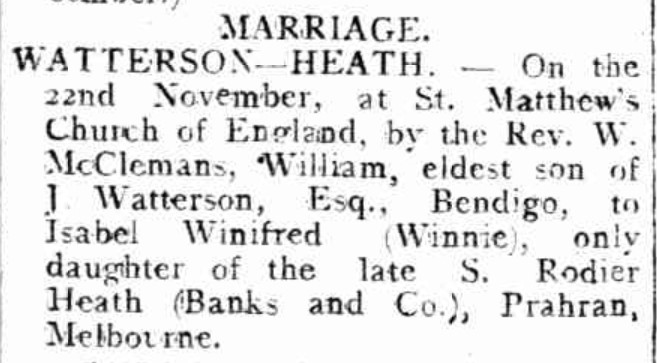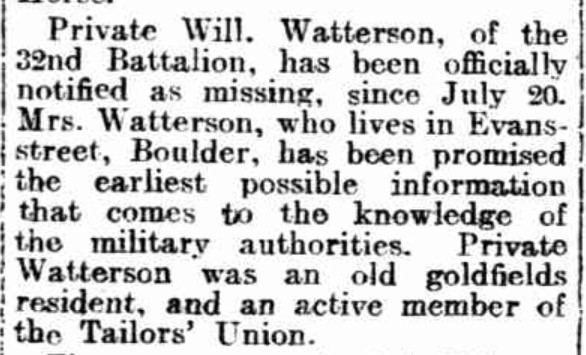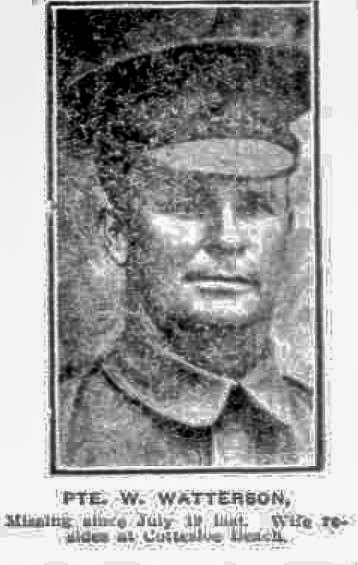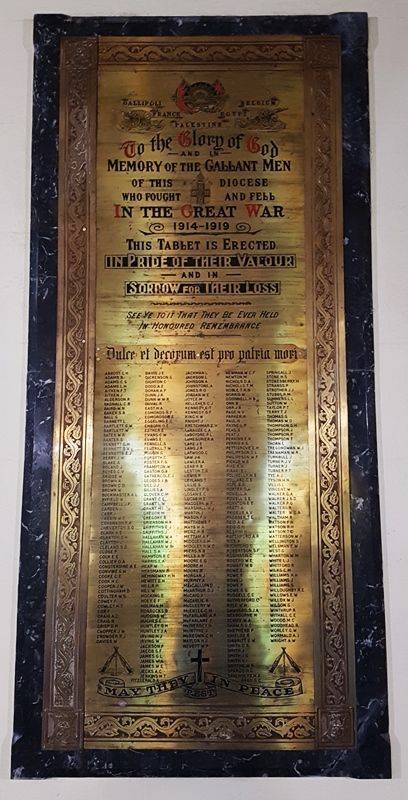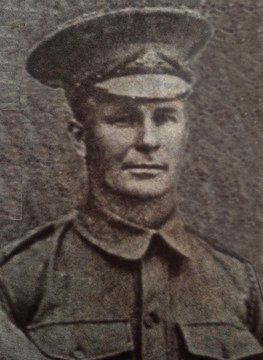
William WATTERSON
Eyes brown, Hair brown, Complexion fair
Two Sons Fall – The Story of William Watterson
Can you help find Will?
Will’s body was never found after the battle, and there are no records of his burial. There is still a chance he might be identified, but we need help. We are still looking for 2 Y DNA and 1 MT DNA donors to help identify Will.
A mass grave was found in 2008 that the Germans had dug for 250 bodies they recovered shortly after the battle. As of 2024 180 of these soldiers have been identified and given proper burials and recognition through finding family DNA donors. Of the remaining soldiers, some identifications are highly likely. We need to find DNA donors.
If you know anything of Will’s contacts here in Australia or his relatives on Isle of Man, we would like to hear from you. See the DNA box at the end of the story for what we know about his family.
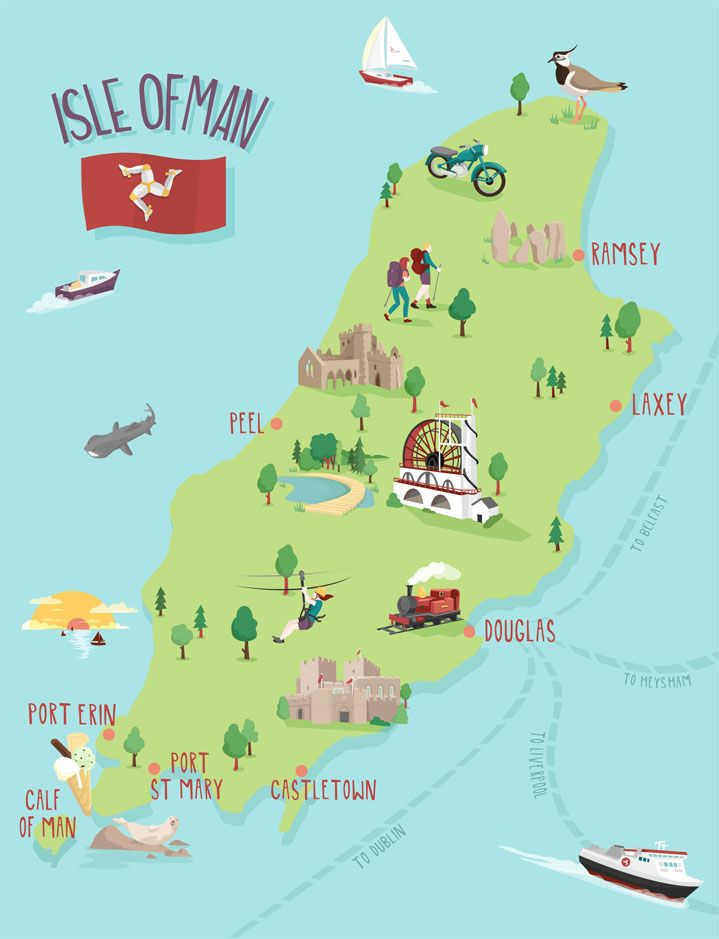
Early Life
William Watterson, born in 1871, was the 4th child and oldest son of John and Margaret Jane Watterson of Sebastapol, near Ballarat, Victoria. John and Jane (the name most commonly used on registration records) hailed from the Isle of Man and were married there in 1863.
In 1864, most likely drawn to the gold mining boom taking place in the Victorian goldfields, the young couple immigrated to Australia and began their family which eventually comprised 3 daughters and 5 sons. John was a leather cutter by trade working at the Bendigo Leather Shop for many years. He was also a Methodist preacher for over 30 years in Bendigo where the family moved circa 1875.
William grew up in a large family with siblings eventually spread far and wide, moving to different states and countries:
- Margaret Watterson 1865–1952 (VIC)
- Amelia Watterson 1866–1952 married Frederick Davison (NSW)
- Jane Jennie Watterson 1869–1937 married Alfred Hansen (VIC)
- William Watterson 1871–1916 married Irene Winifred Heath (WA)
- Herbert Watterson 1873–1954 married Rose Westaway (WA)
- John Henry Watterson 1878–1961 married Annie Keck (USA)
- 'Stanley' Edward Thomas Watterson 1881–1917 (VIC)
- Percival Douglas Watterson 1884–1946 married Lillian Jenkins (NZ)
In 1906, Margaret passed away.
The remains of the late Mrs. Watterson, wife of Mr. John Watterson, were interred on Saturday in the Methodist portion of the Bendigo Cemetery. The cortege moved from the residence of her son-in-law, Mr. A. Hansen, corner of Mackenzie and Honeysuckle streets. The Rev. R. Kelly held services both at the residence and at the graveside. The pallbearers were Messrs. Stonehouse, Kidd, Hansen, and Westaway.
John moved to Sydney for a while but returned to Bendigo and passed away in 1926.
William - tailor and married man
It is likely that William moved to Western Australia around 1897 with his younger brother Herbert arriving in Kalgoorlie around 1900. He was active in the local Tailors’ Union who were fighting for fairer wages and conditions in the industry. Brother Edward was also a tailor in Melbourne.
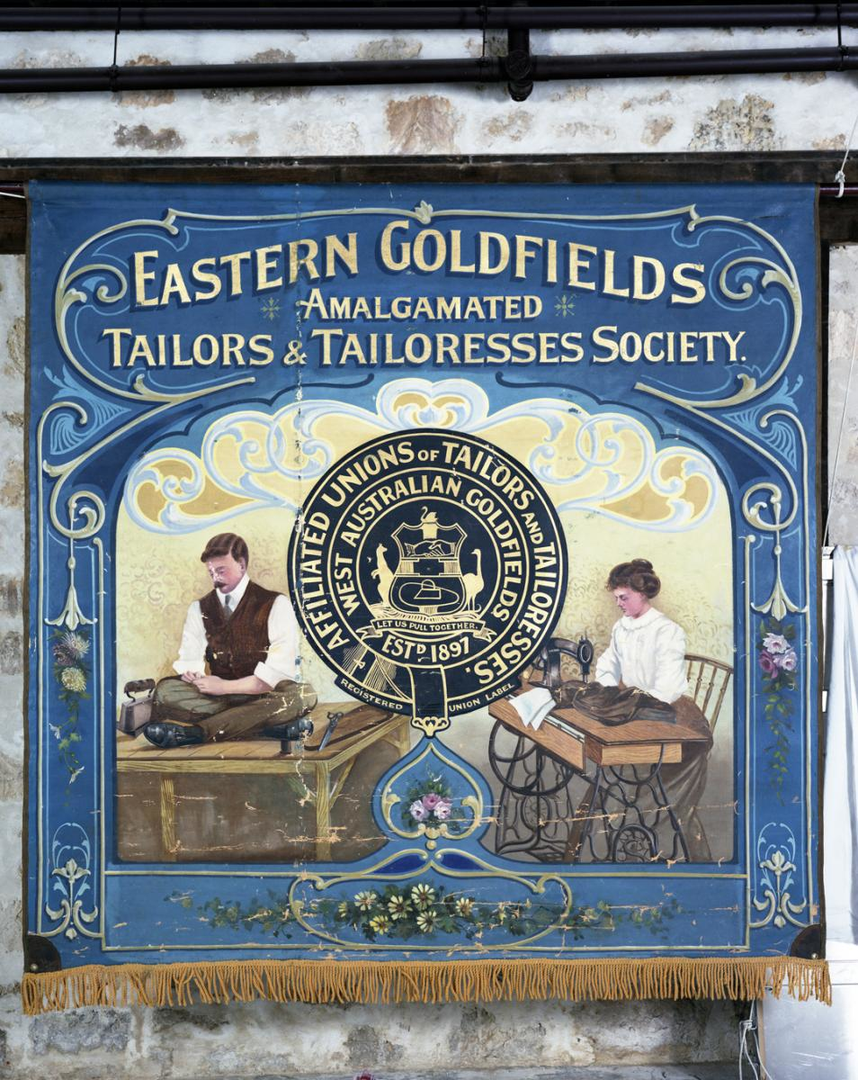
In 1905, William married Isabel Winifred Heath “Winnie” in Kalgoorlie (Boulder), Western Australia. Winnie was a local nurse who, after the war, became a well-known midwife in the region – nurse Wattie Watterson. William and Winnie had no children.
Brothers at War
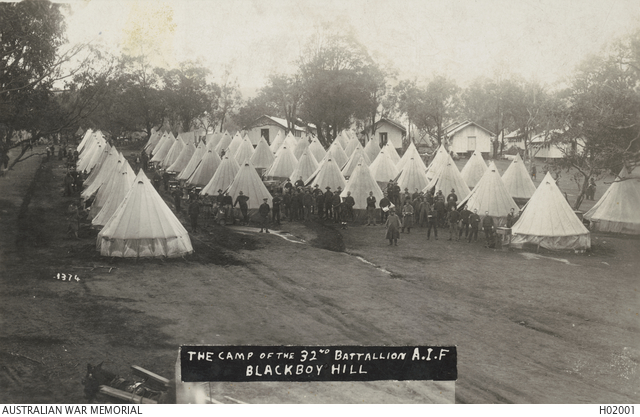
Will enlisted at Blackboy Hill on the 19 July 1915 as part of the 32nd Battalion, D Company. At the age of 44, Will was just under the cut off for soldiers being accepted. Exactly one year later he would be killed in action.
His brother Edward had enlisted under the name Stanley Watterson (the name he was generally known as) on 7 July 1915 in Melbourne and was assigned to the 6th Battalion.
By Christmas, both brothers were in Egypt and then, with their respective battalions, where they were to stay for 6 months training before proceeding to France and the Western Front.
On the night of 19/20 July 1916, the 32nd Battalion was appointed to take up position on a flank in a joint attack on the enemy lines at Fromelles. The attack was meant to be a diversion to draw enemy resources away from the main battle much further south on the Somme but ended in total disaster. The 32nd Battalion made the charge as far as the enemy trenches and beyond, but when support from other battalions was crushed, the 32nd found themselves cut off from their own lines and eventually suffered 718 casualties, almost 75 percent of its total strength. In all, more than 5,500 were killed, wounded or missing in action marking Australia’s worst ever losses in a single day.
On the morning of 20 July 1916, Private 1385 William Watterson was among the many listed as missing in action after the battle of Fromelles.
Meanwhile, Stan remained in the field fighting with the 6th Battalion in France and Belgium.
After the battle
In late August more than six weeks after the Battle of Fromelles, a cable was sent to Australia to advise Winnie Watterson as next of kin that William was missing in action. With no information available through military sources, Winnie made enquiries through the Red Cross for news of Will – whether that included his being wounded, killed or taken prisoner. The document below shows that the Red Cross received a negative response (negatif envoye) to the enquiry – made at Winnie’s instigation - whether Will’s name appeared on any lists of prisoners of war.
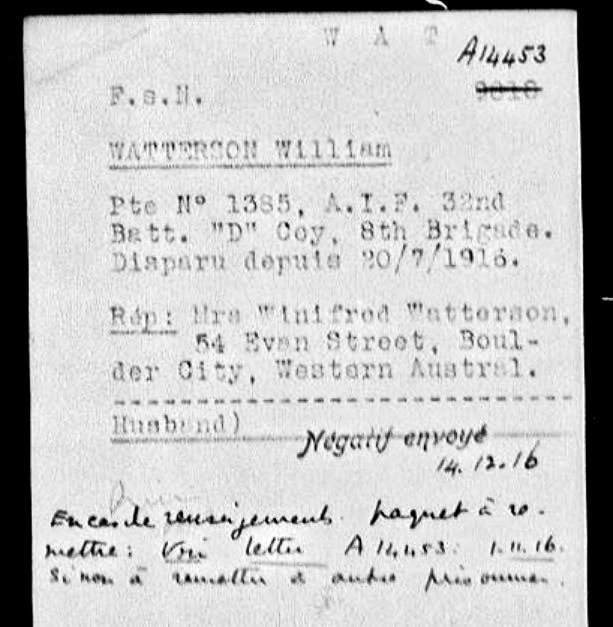
It was not until 12 August 1917 that a court of enquiry was held in the field and found that Private William Watterson had been killed in action on 20 July 1916. His Red Cross file shows no eyewitness or other records, so it seems that none of the surviving soldiers could give direct evidence as to his fate.
On 8 September 1917, the cable was sent to notify Winnie officially that her husband had been killed in action.
Two months later in early November 1917, John Watterson as next of kin was advised that his son Private Stan Watterson was missing after a dreadful battle on 4 October 1917 that became known as the battle of Broodseinde. It was a case of ‘history repeating’ as it was not until August 1918 before a court of enquiry was held and determined that Private 3508 Stanley Watterson had been killed in action. At least for Stan, there was some closure for family in knowing how he died as there were both first- and second-hand reports that Stan had been a part of Lewis Gun team that had been hit by a shell; about seven of them were killed instantly and buried where they fell.
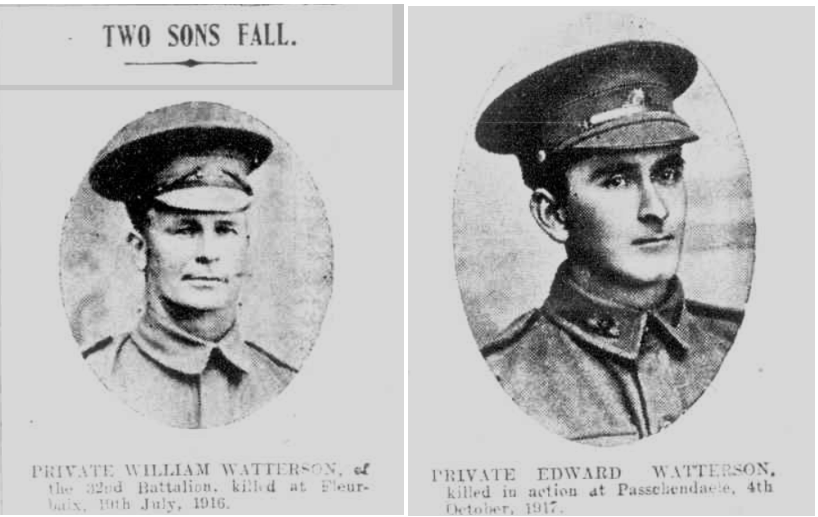
The 1918 news articles included a letter sent to John Watterson by Stan’s commanding officer, Lieutenant Percival Louis Rauert MC:
“Mr. J. Watterson, for many years a resident of Bendigo, but now of Sydney, has received the following letter from Lieutenant Louis Rauert, in reference to the death in action of his son, Edward (of the Lewis gun section, 6th Battalion): —
‘It is with greatest regret that I pen you this short note about your son, Stan (Edward) who has been marked missing since 4th October, 1917. I have delayed this in the hope of finding out later news, but all to no avail. I am only too afraid he was killed a few feet away at about 5.30 on the morn of 4th October, 1917, at the big advance on Passchendale. It was a fearful battle, and many of my men were killed that morn.
I was your son's platoon commander and am in a position to say he was as brave as any man could be. I cannot give too glowing an account of his great gallantry while in action. He was in my platoon also at Pozieres in 1916, and I knew his great qualities. He would go anywhere and do any mortal thing with the greatest of courage. After seeing his great works at Pozieres and then again at Ypres in the battle of 20th September and 4th October, I fall very short of being able to describe to you the glorious and brave deeds he performed regardless of the greatest of danger.
When out of the lines he was the grandest natured boy one would ever wish to meet. Everyone admired him. And his work for concerts was so great; I have the fondest recollections of the lovely evenings we used to have, and he was always the leading one in the entertainment. How we all miss him.
I am sure in your great sadness you will be helped by the thought of what a great and noble soldier he was. His lovely disposition amongst the men made him a royal favourite. His greatest friend, Pte. Jackson, on the same date is also missing, so I am afraid the one shell got the both of them.’
Another son of Mr. Watterson (William) was killed at Fleurbaix on 19th July, 1916. They were both natives of this city, their father having been for some years salesman at the Bendigo leather shop, and was for about half a century connected with the Forest-street Methodist Church.”
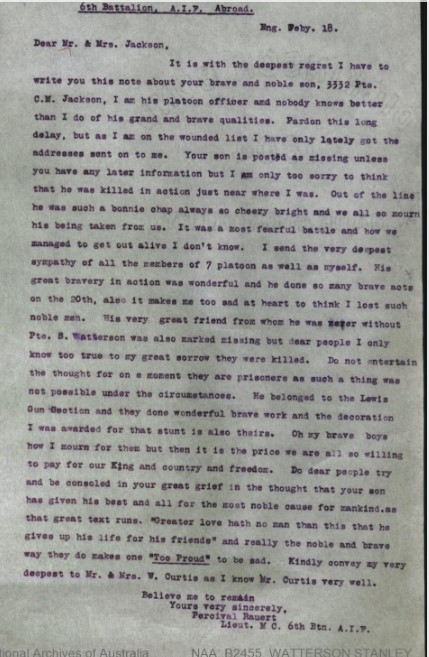
Remembering
Within 15 months, the Watterson family had lost two sons and neither soldier had an identified place of burial. But they were not forgotten.
Herbert Watterson 1873-1954 spoke of the loss of his brothers:
In explaining his position on the Citizens' Committee, at last night's meeting, Mr H. Watterson said that two brothers of his had made the supreme sacrifice, his only son had also enlisted while he, himself, had offered his services but was rejected.
Both William and Stanley are commemorated on the Australian War Memorial Roll of Honour in Canberra, ACT and Stanley’s name is listed on the Menin Gate Memorial at Ypres, Flanders, Belgium and the Bendigo Roll of Honour (Bendigo remembers site).
William is also remembered at:
- VC Corner Australian Cemetery and Memorial, Fromelles, Lille, Nord Pas de Calais, France
- Boulder Roll of Honour, Boulder, Kalgoorlie, Western Australia,
- Kalgoorlie St John's Anglican Church Honour Roll
Will’s wife Isabel (known as Winnie or Watty) became a midwife and went on to have a successful career as a nurse in and around Perth. There are no records of her ever remarrying and she passed away in 1966.
Still Hope to Identify William?
As described at the start of this story, it is possible that William is one of the yet to be identified soldiers from the mass grave that was dug by the Germans and only discovered in 2008. We just need to find DNA donors.
If you know anything of the family contacts in Australia or Isle of Man we would like to hear from you.
DNA samples are still being sought for family connections to
| Soldier | William WATTERSON 1871-1916 married Isabel Winifred HEATH |
| Parents | John WATTERSON b1840, Isle of Man d 1926, Bendigo, Victoria, | ||
| married Margaret Jane FARGHER b1843, Isle of Man d. 1906, Bendigo, Victoria |
| Grandparents | |||
| Paternal | William WATTERSON and Margaret MULLEN, Isle of Man | ||
| Maternal | Thomas FARGHER and Margaret KERMODE, Isle of Man. |
Seeking DNA Donors

Contacts
(Contact: carla@fromelles.info or geoffrey@fromelles.info).
(Contact: army.uwc@defence.gov.au or phone 1800 019 090).
Donations
If you are able, please contribute to the upkeep of this resource.
(Contact: bill@fromelles.info ).
